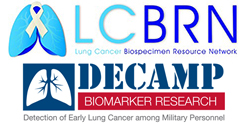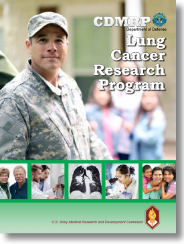Lung Cancer
Vision – To eradicate deaths and suffering from lung cancer to better the health and welfare of Service Members, Veterans, and the general public
Lung cancer is the leading cause of cancer mortality in the United States, accounting for 20% of all deaths.1 This year, more than 234,580 U.S. men and women will be diagnosed with lung cancer, and over 125,000 will die from the disease. Lung cancer is generally diagnosed at an advanced, incurable stage because patients often lack signs and symptoms in the early stages of the disease. Several factors have been shown to contribute to the development of lung cancer, smoking and exposure to environmental carcinogens being the most prevalent; however, 10-15% of lung cancers occur in people who are non-smokers.2 Lung cancer risk for our military is significant, with 24% to as high as 38% of Service Members smoking compared to 14% of civliians.3 Deployments also worsen smoking rates by about 50%. Among military Veterans, lung cancer is a leading cause of cancer-related deaths, with about 15 Veterans dying of lung cancer each day.4 An estimated 900,000 Veterans remain at risk due to age, smoking, and other environmental exposures during and after military service.5 Despite improved screening methods for lung cancer and advances in treatment, the 5-year survival rate remains low at 27% for non-small cell lung cancer and only 7% for small cell lung cancer.1
The LCRP has developed a strategy to address multiple issues in lung cancer research over the cancer continuum of care spectrum. The following Areas of Emphasis are critical gaps in cancer research, care, and/or patient outcomes that, if addressed, will lead to reduced suffering from lung cancer and improved quality of life for Service Members, Veterans, and the general public.
- Biology and Etiology
- Understand the molecular mechanisms of initiation and progression to lung cancer.
- Understand contributors to lung cancer development other than tobacco.
- Understand the biology of metastatic/oligometastatic disease progression.
- Prevention
- Identify innovative strategies for prevention of the occurrence of lung cancer(s) or subsequent primaries.
- Identify innovative strategies for the prevention of recurrence or metastases from lung cancer.
- Detection, Diagnosis, and Surveillance
- Improve and expand approaches to screening and early detection of lung cancer.
- Identify strategies for prompt detection and/or characterization of progressive disease.
- Treatment and Prognosis
- Identify innovative strategies for the treatment of lung cancer, including overcoming resistance.
- Develop or optimize biomarkers to assist with therapeutic decision-making.
- Enhance the understanding, detection, and treatment of brain and leptomeningeal metastases in lung cancer.
- Health Outcomes and Survivorship
- Identify and understand the long-term and cumulative effects of lung cancer and its treatment(s) on patients, families, and support systems with respect to the impact on quality of life including, but not limited to, physiological, psychosocial, cognitive, and financial effects.
- Identify and understand impact of comorbidities on survivorship care in all stages of lung cancer.
- Disparities
- Reduce disparities among high-risk groups and patients with limited access to clinical care and resources.
1 https://seer.cancer.gov/statfacts/html/common.html.
2 https://www.cancer.org/cancer/latest-news/why-lung-cancer-strikes-nonsmokers.html
3 US Secretary of Defense. 2016. Memorandum for Secretaries of the Military Departments. Washington, DC: US Secretary
4 https://www.research.va.gov/programs/pop/lpop.cfm.
5 Moghanaki, D and Hagan M. 2020. Strategic Initiatives for Veterans with Lung Cancer. Federal Practitioner, S76.
![]()
Congressional Appropriations
- $220.5 million
FY09-23 - $25 million
FY24

Funding
Summary
- 425 Awards in
FY09-23 - Recent Applications Recommended for Funding

Programmatic
Panels

Peer Review Participants

LCRP-Supported Key Research Resources
Dr. Avrum Spira
Boston University Medical Campus
Detection of Early Lung Cancer Among Military Personnel (DECAMP)
Last updated Monday, March 17, 2025
















